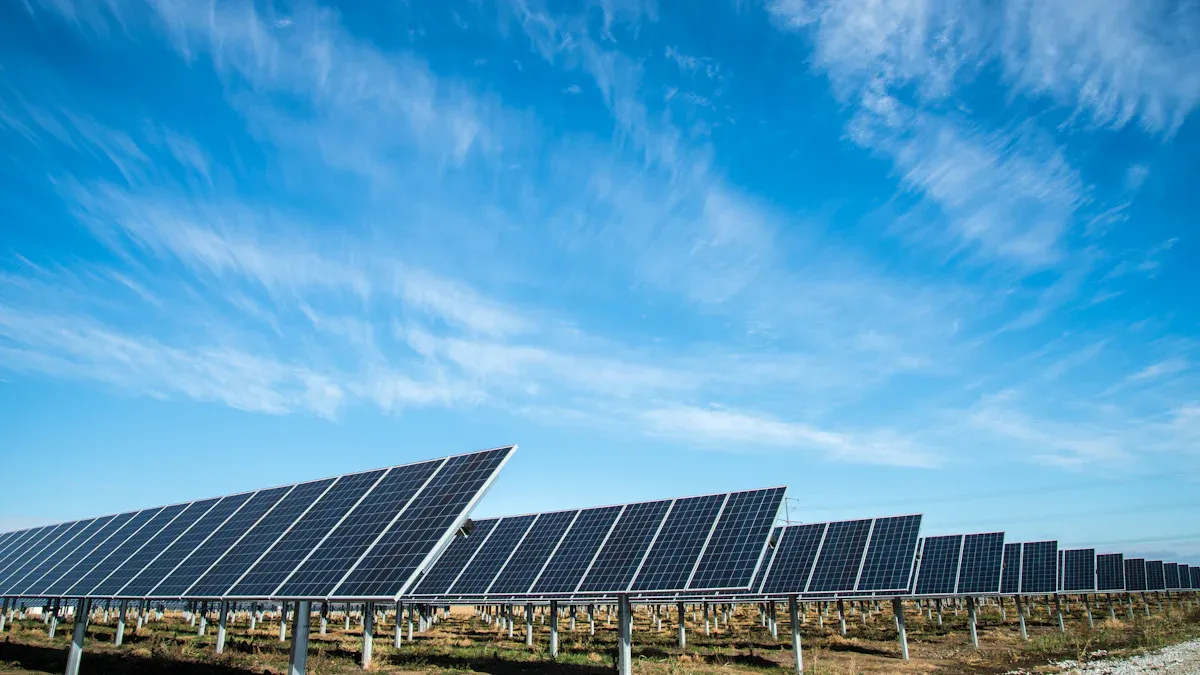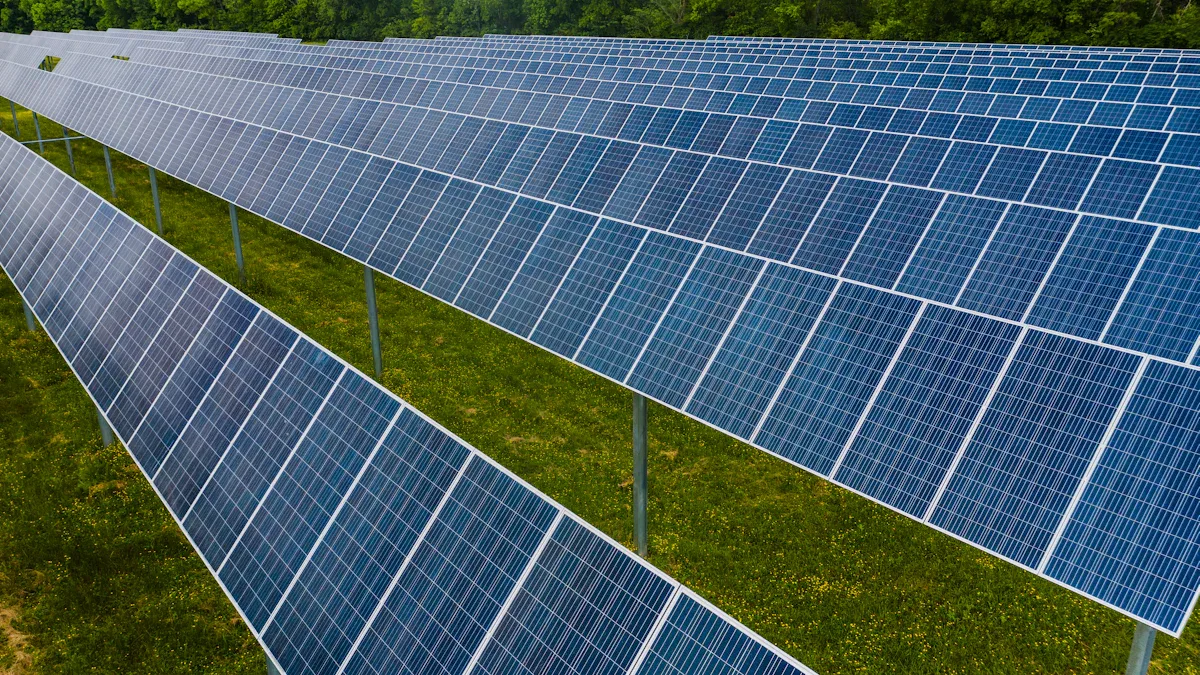
You might wonder how renewable energy systems maintain their efficiency over time. The answer often lies in advanced materials like CVD SIC Coating. This technology boosts the performance of solar cells and power electronics by enhancing their durability. With global energy demands rising, this innovation plays a vital role in sustainable solutions.
Key Takeaways
- CVD SIC Coating helps renewable energy systems work better and last longer.
- More people want renewable energy, so materials like CVD SIC Coating are needed to improve solar panels and wind turbines.
- To use CVD SIC Coating more, we must lower costs and fix technical problems.
Overview of CVD SIC Coatings
What Are CVD SIC Coatings?
CVD SIC Coating stands for chemical vapor deposition silicon carbide coating. This advanced material is created by depositing a thin layer of silicon carbide onto a surface using a chemical vapor process. You might find it interesting that this process happens at high temperatures, allowing the coating to bond tightly to the material underneath. The result is a durable and protective layer that can withstand extreme conditions.
Key Properties of CVD SIC Coatings
CVD SIC Coating offers several unique properties that make it valuable for renewable energy applications:
- High Thermal Stability: It performs well even in high-temperature environments.
- Exceptional Hardness: This coating resists wear and tear, extending the lifespan of components.
- Corrosion Resistance: It protects against chemical damage, especially in harsh environments.
- Electrical Conductivity: It supports efficient energy transfer in electronic systems.
These properties make it a reliable choice for improving the performance of renewable energy technologies.
Applications in Renewable Energy
You’ll see CVD SIC Coating used in various renewable energy systems. In solar panels, it enhances the durability of photovoltaic cells, ensuring they last longer under intense sunlight. Wind turbines also benefit from this coating, as it protects components from wear caused by constant motion and exposure to the elements. Additionally, power electronics in electric vehicles rely on this coating to improve efficiency and reduce energy loss.
By using CVD SIC Coating, renewable energy systems can operate more efficiently and last longer, helping you contribute to a sustainable future.
Market Trends and Growth Drivers

Increasing Global Demand for Renewable Energy
You’ve probably noticed the growing focus on renewable energy worldwide. This shift is driven by the urgent need to reduce carbon emissions and combat climate change. Governments and industries are investing heavily in solar, wind, and other renewable energy sources. As a result, the demand for advanced materials like CVD SIC Coating has surged. These coatings play a critical role in improving the efficiency and durability of renewable energy systems.
For example, solar energy installations are expanding rapidly. Countries are setting ambitious targets to increase their solar power capacity. To meet these goals, manufacturers rely on technologies that enhance the performance of solar panels. CVD SIC Coating ensures that these panels can withstand harsh environmental conditions, making them more reliable and cost-effective over time.
Advancements in CVD Technology
The field of chemical vapor deposition has seen remarkable progress in recent years. These advancements have made it possible to produce CVD SIC Coating with greater precision and efficiency. You’ll find that modern CVD processes are faster and more cost-effective than ever before. This progress has opened up new opportunities for using these coatings in renewable energy applications.
One key innovation is the development of low-temperature deposition techniques. These methods allow coatings to be applied to a wider range of materials without compromising their properties. Another breakthrough is the use of advanced equipment that ensures uniform coating thickness. This uniformity is essential for achieving consistent performance in renewable energy systems.
As CVD technology continues to evolve, you can expect even more efficient and affordable solutions for renewable energy applications.
Role of CVD SIC Coatings in Solar and Wind Energy Systems
CVD SIC Coating plays a vital role in both solar and wind energy systems. In solar panels, it protects photovoltaic cells from damage caused by extreme temperatures and prolonged exposure to sunlight. This protection extends the lifespan of the panels and ensures consistent energy output.
In wind turbines, the coating enhances the durability of critical components like blades and bearings. These parts face constant wear and tear due to high-speed rotation and exposure to the elements. By using CVD SIC Coating, manufacturers can reduce maintenance costs and improve the reliability of wind energy systems.
You’ll also find these coatings in power electronics used in renewable energy systems. They help improve energy transfer efficiency and reduce energy losses. This efficiency is crucial for maximizing the output of renewable energy installations.
With its wide-ranging applications, CVD SIC Coating is a cornerstone of modern renewable energy technologies.
Challenges in Adoption
High Costs of Production
You might wonder why CVD SIC Coating isn’t more widely used despite its benefits. One major reason is the high cost of production. The chemical vapor deposition process requires specialized equipment and operates at extremely high temperatures. These factors increase energy consumption and raise operational expenses.
Raw materials for silicon carbide coatings also contribute to the cost. High-purity silicon and carbon sources are essential for creating a durable and effective coating. These materials are expensive and often difficult to source in large quantities.
For manufacturers, these costs can make it challenging to scale production. Smaller companies may struggle to compete, limiting the availability of CVD SIC Coating in the market.
Reducing production costs will be essential for making this technology more accessible to renewable energy sectors.
Technical Barriers in Manufacturing
Producing CVD SIC Coating involves complex processes that require precision and expertise. You’ll find that even small errors during deposition can lead to uneven coatings or defects. These issues can compromise the performance of renewable energy systems.
Another challenge lies in adapting the coating process to different materials. Not all substrates can withstand the high temperatures required for chemical vapor deposition. This limitation restricts the range of applications for CVD SIC Coating.
Manufacturers also face difficulties in maintaining consistent quality. Variations in coating thickness or composition can affect the durability and efficiency of the final product. Achieving uniformity requires advanced equipment and skilled technicians, which adds to the complexity of production.
Overcoming these technical barriers will require ongoing research and development in manufacturing techniques.
Need for Process Innovations
Innovation is key to addressing the challenges associated with CVD SIC Coating. You’ll see that current production methods are not always efficient or cost-effective. Developing new techniques could help reduce energy consumption and streamline the deposition process.
One promising area of research is low-temperature deposition. This approach could make it possible to apply coatings to a wider variety of materials. Another potential innovation involves using alternative raw materials that are more affordable and sustainable.
Automation and artificial intelligence could also play a role in improving manufacturing efficiency. By automating certain steps, manufacturers could reduce errors and ensure consistent quality. AI-driven systems could optimize the deposition process, saving time and resources.
Embracing these innovations will be crucial for expanding the use of CVD SIC Coating in renewable energy applications.
Innovations and Opportunities

Recent Technological Advancements
You’ve likely noticed how technology evolves rapidly, and CVD SIC Coating is no exception. Recent advancements have focused on improving deposition techniques to make coatings more precise and efficient. For instance, researchers have developed methods to reduce the energy required during the chemical vapor deposition process. This innovation lowers production costs and makes the technology more accessible.
Another breakthrough involves nanostructured coatings. These coatings enhance the material’s properties, such as thermal stability and wear resistance. You’ll find that these improvements make renewable energy systems even more reliable.
As technology progresses, you can expect CVD SIC Coating to become more versatile and cost-effective.
Emerging Applications in Renewable Energy
CVD SIC Coating is finding its way into new renewable energy applications. You’ll see it being used in advanced battery systems for energy storage. These coatings improve the efficiency and lifespan of batteries, making them ideal for storing solar and wind energy.
Hydrogen fuel cells also benefit from this technology. The coating protects components from corrosion, ensuring long-term performance. Additionally, researchers are exploring its use in next-generation solar panels, where it could boost energy conversion rates.
These emerging applications highlight the growing importance of CVD SIC Coating in renewable energy innovation.
Market Growth Opportunities
The renewable energy market offers significant growth opportunities for CVD SIC Coating. Governments worldwide are investing in green energy projects, creating a demand for advanced materials. You’ll find that solar and wind energy sectors are expanding rapidly, driving the need for durable and efficient coatings.
Private companies are also contributing to this growth. Many are adopting sustainable practices and seeking materials that enhance the performance of their products. This trend opens up new markets for CVD SIC Coating, especially in electric vehicles and energy storage systems.
By tapping into these opportunities, the industry can accelerate the transition to a sustainable future.
Regional Insights
Asia-Pacific as a Key Market
Asia-Pacific leads the global demand for CVD SIC coatings. Countries like China, India, and Japan are investing heavily in renewable energy projects. You’ll notice that China dominates solar panel production, making it a major consumer of advanced coatings. India is rapidly expanding its wind and solar energy capacity, creating new opportunities for CVD SIC coatings.
Japan focuses on innovation in energy storage and hydrogen fuel cells. These technologies rely on durable materials like silicon carbide coatings. Southeast Asian nations are also increasing their renewable energy investments, further boosting demand.
🌏 Asia-Pacific’s renewable energy growth makes it a critical market for CVD SIC coatings.
Europe’s Renewable Energy Expansion
Europe has set ambitious goals for reducing carbon emissions. You’ll find that countries like Germany, Spain, and Denmark are leading the way in wind and solar energy adoption. Germany’s focus on solar energy has driven demand for coatings that enhance panel efficiency.
The European Union supports green energy projects through funding and policies. This support encourages the use of advanced materials like CVD SIC coatings. Offshore wind farms in the North Sea also benefit from these coatings, which protect components from harsh marine environments.
💡 Europe’s commitment to sustainability drives innovation in renewable energy technologies.
North America’s Contribution to Demand
North America plays a significant role in the CVD SIC coating market. The United States invests heavily in solar and wind energy projects. You’ll see that many companies focus on improving energy storage systems, where these coatings are essential.
Canada emphasizes hydropower and wind energy, creating additional demand for durable materials. Mexico is also expanding its renewable energy sector, particularly in solar power. These developments make North America a growing market for CVD SIC coatings.
🌟 North America’s renewable energy initiatives highlight the importance of advanced materials.
The demand for CVD SIC coatings will continue to rise as renewable energy technologies advance. You’ll see this growth fueled by the global push for sustainability.
- Key Challenges: High production costs and technical barriers remain obstacles. Addressing these issues will unlock the full potential of this technology.
- Future Outlook: Innovation and regional market expansion will shape the future of CVD SIC coatings.
🌟 Your role in adopting these advancements can drive a more sustainable energy future.
FAQ
What makes CVD SIC coatings essential for renewable energy systems?
CVD SIC coatings improve durability, thermal stability, and efficiency in renewable energy systems. These properties help solar panels, wind turbines, and power electronics perform better and last longer.
Are CVD SIC coatings environmentally friendly?
Yes, these coatings support sustainability by enhancing the lifespan and efficiency of renewable energy technologies. This reduces waste and promotes cleaner energy production.
How can manufacturers reduce the cost of CVD SIC coatings?
Manufacturers can adopt low-temperature deposition techniques, automate processes, and explore alternative raw materials. These innovations lower production costs and make the technology more accessible.
💡 Have more questions? Share them in the comments below!


